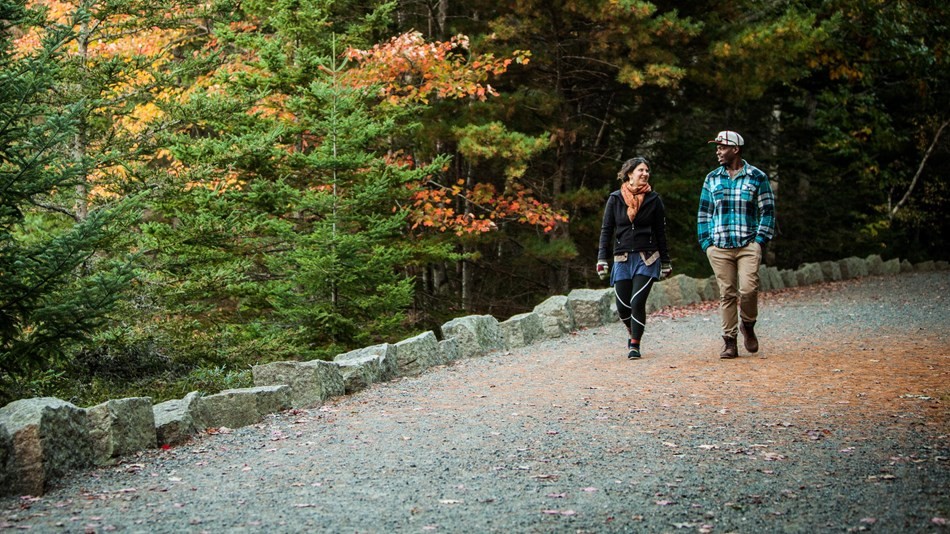
The Acadia National Park was established in 1916 and annually welcomes approximately 3.5 million people.
Source: Credit to National Park Service
| Project Name | Acadia National Park | |
|---|---|---|
| Location | Bar Harbor, Maine | |
| Project Sponsor / Borrower | The National Park Service | |
| Program Areas |
|
|
| Value Capture Techniques | Private Contribution, Friends of Acadia endowment fund, & Volunteers | |
| Mode | National Park Road and Bridge | |
| Description |
Acadia National park in Maine encompasses 49,052 acres in three main areas. The largest is located on Mount Desert Island, an island that is connected to the mainland by a bridge. Next, is an approximate 2,366-acre tract of land to the Northeast on the mainland at Schoodic Peninsula. Thirdly, to the Southwest and accessible only by boat, is Isle Au Haut, the least-visited unit of the park. Baker Island and Bar Island also have National Park land. Because the park is not self-contained, there is no official entrance other than a pay station on the scenic Park Loop Road on Mount Desert Island. However, there is still a fee to use any of the federal parking areas and to drive the loop road, so visitors need to purchase an entrance pass. Acadia is one of the top 10 visited national parks and it includes 158 miles of hiking trails, 45 miles of carriage roads, 27 miles of historic motor roads, 26 mountains, and 26 lakes or ponds. The park, which receives over 3.5 million visitors a year, supports over 1100 vascular plant species. It offers hiking, biking, camping, and scenic views. The carriage roads and stone bridges in Acadia National Park were financed and directed by philanthropist John D. Rockefeller, Jr., between 1913 and 1940, for hikers, bikers, horseback riders, and carriages. The network includes 57 miles of woodland roads free of motor vehicles that allow seasonal cross-country skiing and limited snowmobiling. Acadia's carriage roads are the nation's best example of the broken-stone roads commonly used at the turn of the 20th century. They are true roads, approximately 16 feet wide, constructed with methods that required hand labor. Engineered to contend with Maine's wet weather, stone culverts, wide ditches, three layers of rock, and a substantial six- to eight-inch crown ensured good drainage. Rather than flattening hillsides to accommodate the roads, breast walls and retaining walls were built to preserve the line of hillsides and save trees. Rockefeller aligned the roads to follow the contours of the land and to take advantage of scenic views. He graded them so they were not too steep or too sharply curved for horse-drawn carriages. |
|
| Cost |
This national park is unusual because it was neither carved out of public lands nor bought with public funds. It was envisioned and donated through the efforts of private citizens. The Carriage Roads and stone bridges in Acadia National Park were financed and directed by philanthropist John D. Rockefeller, Jr., between 1913 and 1940, for hikers, bikers, horseback riders and carriages. |
|
| Funding Sources |
|
|
| Project Delivery / Contract Method | Design-Bid-Build | |
| Private Partner | John D. Rockefeller Jr. | |
| Project Advisors / Consultants | N/A | |
| Lenders | N/A | |
| Duration / Status |
1916 1929 1986 2016 |
|
| Financial Status/Financial Performance |
Every American who pays Federal income taxes contributes to the national parks budget, as the Federal government foots the bill for the National Park Service. The national park budget is separated into two categories: discretionary and mandatory funds. Each year, the NPS submits a budget proposal that gets wrapped into the budget for the Department of the Interior and the Executive Branch as a whole. That proposed budget then goes to Congress for review. A fee is required to visit any part of the Acadia National Park. The $30-per-vehicle fee is good for a seven-day pass. An annual Acadia Park Pass costs $55 and is good for a year. Fees for visitors on a motorcycle are $25, $15 for those on foot or bicycle, and $15 per person for vehicles with 16 or more passengers. |
|
| Innovations |
|
|
| Related Links / Articles |
|
|
| Contact |
Sally Mayberry (928) 638-7888 Sally_Mayberry@nps.gov |
|

The wooden signpost with the place names on Carriage Road, Bar Harbor, Maine for Bicycling, Horseback Riding, Hiking, and the Winter Activities (cross-country skiing or snowshoeing)
Source: Credit to National Park Service, Friends of Acadia, NPS